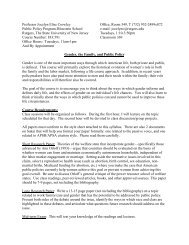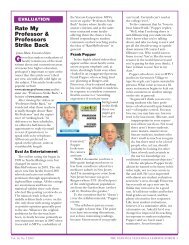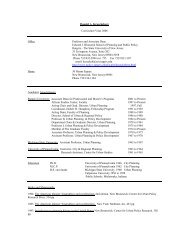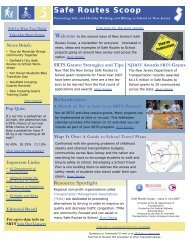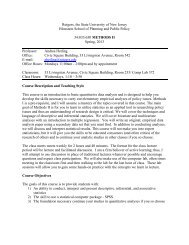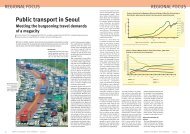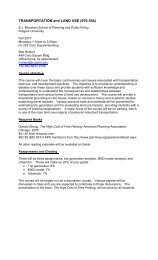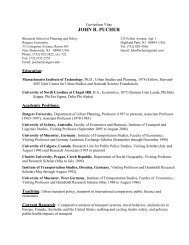Cycling for Everyone - Bloustein School of Planning and Public ...
Cycling for Everyone - Bloustein School of Planning and Public ...
Cycling for Everyone - Bloustein School of Planning and Public ...
Create successful ePaper yourself
Turn your PDF publications into a flip-book with our unique Google optimized e-Paper software.
Pucher <strong>and</strong> Buehler <strong>Cycling</strong> <strong>for</strong> <strong>Everyone</strong><br />
<strong>Cycling</strong> <strong>for</strong> <strong>Everyone</strong>: Lessons from Europe<br />
by John Pucher <strong>and</strong> Ralph Buehler<br />
Rutgers University<br />
Corresponding Author:<br />
Pr<strong>of</strong>. John Pucher, Rutgers University<br />
<strong>Bloustein</strong> <strong>School</strong> <strong>of</strong> <strong>Planning</strong> <strong>and</strong> <strong>Public</strong> Policy<br />
33 Livingston Avenue, Room 363<br />
New Brunswick, New Jersey 08901-1987<br />
Tel: (732) 932-3822, ext. 722<br />
Fax: (732) 932-2253<br />
Email: pucher@rci.rutgers.edu; JohnPucher@gmail.com<br />
Ralph Buehler, PhD C<strong>and</strong>idate<br />
Rutgers, The State University <strong>of</strong> New Jersey<br />
<strong>Bloustein</strong> <strong>School</strong> <strong>of</strong> <strong>Planning</strong> <strong>and</strong> <strong>Public</strong> Policy<br />
33 Livingston Avenue, Room 566<br />
New Brunswick, New Jersey 08901-1987<br />
Email: ralphbu@eden.rutgers.edu; Ralph.Buehler@gmail.com<br />
6,686 words (text <strong>and</strong> references)<br />
3 figures (3 * 250 words = 750 words)<br />
Total: 7,436 (including text, references, <strong>and</strong> figures)<br />
Original submission date: 06. July 2007<br />
Revised <strong>and</strong> resubmitted: 25. October 2007
Pucher <strong>and</strong> Buehler <strong>Cycling</strong> <strong>for</strong> <strong>Everyone</strong><br />
Abstract<br />
This paper investigates how bicycling can be promoted as a safe <strong>and</strong> feasible<br />
means <strong>of</strong> transport <strong>for</strong> everyone <strong>and</strong> <strong>for</strong> all trip purposes. The policies <strong>and</strong><br />
programs needed to encourage a broad spectrum <strong>of</strong> social groups to cycle are the<br />
same policies <strong>and</strong> programs that encourage high overall levels <strong>of</strong> cycling: extensive<br />
systems <strong>of</strong> separate cycling facilities, intersection modifications <strong>and</strong> priority bicycle<br />
traffic signals, traffic calming <strong>of</strong> neighborhoods, safe <strong>and</strong> convenient bike parking,<br />
coordination <strong>and</strong> integration <strong>of</strong> cycling with public transport, traffic education <strong>and</strong><br />
training <strong>for</strong> both cyclists <strong>and</strong> motorists, <strong>and</strong> traffic laws that favor cyclists <strong>and</strong><br />
pedestrians. To show how this multifaceted, coordinated approach actually works,<br />
we focus in this paper on cycling trends <strong>and</strong> policies in the Netherl<strong>and</strong>s, Denmark,<br />
<strong>and</strong> Germany. We supplement our national level comparative analysis with case<br />
studies <strong>of</strong> large <strong>and</strong> small cities in each country.<br />
Introduction<br />
The European Union has <strong>of</strong>ficially recognized the importance <strong>of</strong> cycling as a<br />
practical mode <strong>of</strong> urban transport, generating environmental, economic, <strong>and</strong> health<br />
benefits (1). The United States Department <strong>of</strong> Transportation emphasizes the same<br />
benefits <strong>and</strong> sets the specific goal <strong>of</strong> doubling the percentage <strong>of</strong> trips made by cycling<br />
<strong>and</strong> walking (2).<br />
Un<strong>for</strong>tunately, cycling levels in the USA lag far behind those in most European<br />
countries. <strong>Cycling</strong> here is primarily <strong>for</strong> recreation <strong>and</strong> not <strong>for</strong> daily, utilitarian travel.<br />
Equally important, from a social perspective, cycling is limited mainly to young men. In<br />
sharp contrast, cycling in northern Europe is as common <strong>for</strong> women as <strong>for</strong> men, <strong>and</strong><br />
declines only slightly with age. In short, cycling in northern Europe is a normal way <strong>of</strong><br />
getting around cities—<strong>for</strong> everyone <strong>and</strong> <strong>for</strong> all trip purposes.<br />
If cycling is ever to become a viable way <strong>of</strong> getting around American cities, it<br />
must be made safe, convenient, <strong>and</strong> feasible <strong>for</strong> all ages <strong>and</strong> <strong>for</strong> women as well as men.<br />
<strong>Cycling</strong> remains a marginal mode <strong>of</strong> transport in most American cities because it is<br />
2
Pucher <strong>and</strong> Buehler <strong>Cycling</strong> <strong>for</strong> <strong>Everyone</strong><br />
widely viewed as requiring special equipment <strong>and</strong> training, physical fitness, <strong>and</strong> the<br />
courage <strong>and</strong> willingness to battle with motor vehicles on streets without separate bike<br />
lanes or paths. <strong>Cycling</strong> is a mainstream mode <strong>of</strong> urban travel in northern Europe<br />
precisely because it does not require any <strong>of</strong> those things. For example, most northern<br />
European cyclists ride on simple, inexpensive bikes, almost never wear special cycling<br />
outfits, <strong>and</strong> rarely use safety helmets.<br />
The Netherl<strong>and</strong>s, Denmark, <strong>and</strong> Germany have been especially successful in<br />
promoting safe <strong>and</strong> convenient cycling. Despite high rates <strong>of</strong> car ownership, these three<br />
countries have achieved high overall bike shares <strong>of</strong> urban travel, ranging from 9% in<br />
Germany to 19% in Denmark <strong>and</strong> 27% in the Netherl<strong>and</strong>s, far higher than the 1% bike<br />
share <strong>of</strong> travel in the USA (3, 4, 5, 6). Equally impressive, German, Danish, <strong>and</strong> Dutch<br />
women cycle as <strong>of</strong>ten as men, <strong>and</strong> all age groups make a considerable percentage <strong>of</strong> their<br />
daily trips by bike.<br />
Several studies have examined a variety <strong>of</strong> policies <strong>and</strong> programs intended to<br />
encourage more cycling in Europe by making it safer <strong>and</strong> more convenient (1, 6, 7, 8, 9,<br />
10). This paper updates those studies <strong>and</strong> supplements their in<strong>for</strong>mation with new data<br />
from the Netherl<strong>and</strong>s, Denmark, <strong>and</strong> Germany, including both aggregate national data<br />
<strong>and</strong> city case studies. The main objective is to identify <strong>and</strong> categorize the policies <strong>and</strong><br />
programs successful cycling cities have in common with each other, <strong>and</strong> to provide a<br />
thematic framework <strong>for</strong> implementation.<br />
The paper begins by documenting differences among countries in their overall levels<br />
<strong>of</strong> cycling, bike trip purposes, <strong>and</strong> the gender, age, <strong>and</strong> income characteristics <strong>of</strong> cyclists.<br />
Differences in cycling safety help explain some <strong>of</strong> the difference in cycling levels among<br />
3
Pucher <strong>and</strong> Buehler <strong>Cycling</strong> <strong>for</strong> <strong>Everyone</strong><br />
countries; thus, there is an entire section devoted to international comparisons <strong>of</strong> cycling<br />
fatality <strong>and</strong> injury rates <strong>and</strong> trends over time.<br />
The subsequent sections <strong>of</strong> the paper summarize the wide range <strong>of</strong> coordinated<br />
policies <strong>and</strong> programs used in the Netherl<strong>and</strong>s, Denmark, <strong>and</strong> Germany to promote<br />
cycling by everyone <strong>and</strong> at the same time improve cycling safety. The paper concludes<br />
with an overall assessment <strong>of</strong> the lessons that can be learned from northern Europe to<br />
move cycling more toward the mainstream here in the USA.<br />
Variations among Countries in Overall <strong>Cycling</strong> Levels<br />
As shown in Figure 1, there are large differences between Australia, the United<br />
States, Canada, <strong>and</strong> European countries in the bike share <strong>of</strong> trips, ranging from a low <strong>of</strong><br />
only 1% in Australia <strong>and</strong> the USA to 27% in the Netherl<strong>and</strong>s. These differences in the<br />
bike share <strong>of</strong> trips roughly parallel differences in the average distance cycled per person<br />
per day, an alternative way <strong>of</strong> measuring <strong>and</strong> comparing cycling levels among countries.<br />
The European Conference <strong>of</strong> the Ministers <strong>of</strong> Transport estimated that per capita cycling<br />
per day ranges from a high <strong>of</strong> 2.5km in the Netherl<strong>and</strong>s to a low <strong>of</strong> only 0.1 km in Spain,<br />
Greece, <strong>and</strong> Portugal (1). The USA is also at the low end <strong>of</strong> the spectrum, averaging 0.1<br />
km <strong>of</strong> cycling per person per day. Germany (0.9km) <strong>and</strong> Denmark (1.6km) are near the<br />
top, immediately following the Netherl<strong>and</strong>s in distance cycled per inhabitant.<br />
These statistics on cycling levels reflect data provided directly by federal<br />
ministries <strong>of</strong> transport <strong>and</strong> central statistical bureaus in each country. They are not<br />
entirely comparable because national travel surveys vary somewhat according to variable<br />
definitions, data collection method <strong>and</strong> frequency, target population, sample size, <strong>and</strong><br />
response rates (11). At the very least, however, the national travel surveys facilitate<br />
4
Pucher <strong>and</strong> Buehler <strong>Cycling</strong> <strong>for</strong> <strong>Everyone</strong><br />
approximate comparisons <strong>of</strong> different levels <strong>of</strong> cycling among countries, <strong>and</strong> whatever<br />
their limitations, they are the best available sources <strong>of</strong> in<strong>for</strong>mation.<br />
Figure 1. Bicycle Share <strong>of</strong> Trips in Europe, North America, <strong>and</strong> Australia (percent <strong>of</strong><br />
total trips by bicycle) (1), (2), (3), (5)<br />
One might expect that Europeans cycle more than Americans due to shorter trip lengths<br />
in European cities. In fact, a considerably higher percentage <strong>of</strong> all trips in European<br />
cities are shorter than 2.5km: 44% in the Netherl<strong>and</strong>s, 37% in Denmark, <strong>and</strong> 41% in<br />
Germany, compared to 27% in the USA (1, 3, 4, 5, 12, 18). Even controlling <strong>for</strong> trip<br />
distance, however, northern Europeans make a much higher percentage <strong>of</strong> their local trips<br />
by bike. For example, Americans cycle <strong>for</strong> only 2% <strong>of</strong> trips shorter than 2.5km,<br />
compared to 37% in the Netherl<strong>and</strong>s, 27% in Denmark, <strong>and</strong> 14% in Germany.<br />
5
Pucher <strong>and</strong> Buehler <strong>Cycling</strong> <strong>for</strong> <strong>Everyone</strong><br />
Not only do northern Europeans cycle more than Americans at every trip distance,<br />
but they are far more likely to cycle <strong>for</strong> practical, utilitarian purposes. Travel to work or<br />
school accounts <strong>for</strong> only 11% <strong>of</strong> all bike trips in the USA, compared to 22% in Germany,<br />
32% in the Netherl<strong>and</strong>s, <strong>and</strong> 38% in Denmark. Similarly, shopping trips account <strong>for</strong> only<br />
5% <strong>of</strong> all bike trips in the USA, compared to 20% in Germany, 22% in the Netherl<strong>and</strong>s,<br />
<strong>and</strong> 25% in Denmark (3, 4, 5, 12). Roughly three-fourths <strong>of</strong> all bike trips in the USA are<br />
<strong>for</strong> recreation, compared to 35% in Germany, 27% in the Netherl<strong>and</strong>s, <strong>and</strong> 24% in<br />
Denmark.<br />
Those large differences in trip purpose suggest that the much higher levels <strong>of</strong><br />
cycling in northern Europe are due to the use <strong>of</strong> bikes <strong>for</strong> a wide range <strong>of</strong> trip purposes,<br />
especially <strong>for</strong> daily utilitarian travel. Conversely, the very low levels <strong>of</strong> cycling in the<br />
USA might be due to mainly recreational cycling here, which is far less frequent. If that<br />
is true, then ef<strong>for</strong>ts to increase cycling in the USA should perhaps focus more on<br />
utilitarian, daily travel within cities as opposed to the recent emphasis on recreational<br />
cycling facilities in parks <strong>and</strong> rural areas.<br />
Some readers might assume that bicycling levels in Western Europe have been<br />
consistently high. In fact, cycling in Western Europe fell sharply during the 1950s <strong>and</strong><br />
1960s, when car ownership increased rapidly <strong>and</strong> cities started spreading out. A Dutch<br />
study showed that, from 1950 to 1975, the bike share <strong>of</strong> trips fell by roughly two-thirds in<br />
a sample <strong>of</strong> Dutch, Danish, <strong>and</strong> German cities, from 50-85% <strong>of</strong> trips in 1950 to only 14-<br />
35% <strong>of</strong> trips in 1975 (6). Similarly, a study by the City <strong>of</strong> Berlin (13) found that the<br />
number <strong>of</strong> bike trips there fell by 78% from 1950 to 1975. During that 25-year period,<br />
cities throughout the Netherl<strong>and</strong>s, Denmark, <strong>and</strong> Germany focused on accommodating<br />
6
Pucher <strong>and</strong> Buehler <strong>Cycling</strong> <strong>for</strong> <strong>Everyone</strong><br />
<strong>and</strong> facilitating increased car use by vastly exp<strong>and</strong>ing roadway capacity <strong>and</strong> parking<br />
supply, while largely ignoring the needs <strong>of</strong> pedestrians <strong>and</strong> cyclists (14).<br />
In the mid-1970s, transport <strong>and</strong> l<strong>and</strong> use policies in all three countries<br />
dramatically shifted to favor walking, cycling, <strong>and</strong> public transport over the private car.<br />
To some extent, this was a reaction to the increasingly harmful environmental, energy,<br />
<strong>and</strong> safety impacts <strong>of</strong> rising car use (1, 6, 14, 15, 16). Most cities vastly improved their<br />
bicycling infrastructure while imposing ever more restrictions on car use <strong>and</strong> making it<br />
more expensive. That policy reversal led to turnarounds in the previous decline <strong>of</strong> bike<br />
use. From 1975 to 1995, the bicycling share <strong>of</strong> trips in the previously cited sample <strong>of</strong><br />
Dutch, Danish, <strong>and</strong> German cities rose by roughly a fourth, resulting in 1995 bike shares<br />
<strong>of</strong> 20-43%. In Berlin, the total number <strong>of</strong> bike trips quadrupled from 1975 to 2001<br />
(increasing by 275%), reaching 45% <strong>of</strong> the 1950 bicycling level (13). The rebound in<br />
cycling from 1975 is especially impressive given the continuing growth in per-capita<br />
income, car ownership <strong>and</strong> suburban development in all three countries over the past<br />
three decades.<br />
Analysis <strong>of</strong> nationwide aggregate data (as opposed to only a few sampled cities,<br />
as above) confirms a rebound in cycling since the 1970s. Average daily km cycled per<br />
inhabitant rose in all three countries over the period 1978 to 2005: from 0.6 to 1.0 in<br />
Germany, from 1.3 to 1.6 in Denmark, <strong>and</strong> from 1.7 to 2.5 in the Netherl<strong>and</strong>s (1, 5, 17,<br />
18).<br />
Not only do these three countries have high <strong>and</strong> growing levels <strong>of</strong> cycling, but<br />
cyclists comprise virtually all segments <strong>of</strong> society. For example, women are just about as<br />
likely to cycle as men. Women make 45% <strong>of</strong> all bike trips in Denmark, 49% in<br />
7
Pucher <strong>and</strong> Buehler <strong>Cycling</strong> <strong>for</strong> <strong>Everyone</strong><br />
Germany, <strong>and</strong> 55% in the Netherl<strong>and</strong>s (17, 18, 19). That compares with only 24% in the<br />
USA (3).<br />
Another dimension <strong>of</strong> cycling’s universality in northern Europe is the<br />
representation <strong>of</strong> all age groups. Children <strong>and</strong> adolescents have the highest rates <strong>of</strong><br />
cycling in almost every country. As shown in Figure 2, however, cycling levels in<br />
northern Europe remain high even among the elderly.<br />
Figure 2. Bicycling Share <strong>of</strong> Trips by Age Group in the Netherl<strong>and</strong>s, Denmark,<br />
Germany, <strong>and</strong> the USA (2000-2002) (3), (4), (17), (18)<br />
In northern Europe there are no significant differences in cycling rates among<br />
income classes. For example, the 2002 national travel survey in Germany revealed that<br />
the lowest-income quartile was only slightly more likely to travel by bike (10% <strong>of</strong> trips)<br />
than the highest-income quartile (8.3%). Similarly, cyclists are distributed evenly among<br />
income classes in the Netherl<strong>and</strong>s <strong>and</strong> Denmark (5, 17).<br />
8
Pucher <strong>and</strong> Buehler <strong>Cycling</strong> <strong>for</strong> <strong>Everyone</strong><br />
The remainder <strong>of</strong> this article examines possible reasons why cycling in Germany,<br />
the Netherl<strong>and</strong>s, <strong>and</strong> Denmark is truly <strong>for</strong> everyone.<br />
Trends in <strong>Cycling</strong> Safety<br />
Perhaps the most important reason <strong>for</strong> the higher levels <strong>of</strong> cycling in northern<br />
Europe—especially among women, children, <strong>and</strong> the elderly—is that cycling is much<br />
safer there than in the USA. Both fatality <strong>and</strong> injury rates are much higher <strong>for</strong> cyclists in<br />
the USA compared to Germany, Denmark, <strong>and</strong> the Netherl<strong>and</strong>s. Averaged over the years<br />
2002 to 2005, the number <strong>of</strong> American bicyclist fatalities per 100 million km cycled was<br />
5.8, compared to 1.7 in Germany, 1.5 in Denmark, <strong>and</strong> 1.1 in the Netherl<strong>and</strong>s (see Figure<br />
3). Thus, cycling is over five times as safe in the Netherl<strong>and</strong>s as in the USA, which<br />
probably explains why the Dutch do not perceive cycling as a dangerous way to get<br />
around. <strong>Cycling</strong> in Germany <strong>and</strong> Denmark is not quite as safe as in the Netherl<strong>and</strong>s, but<br />
still 3-4 times safer than in the USA.<br />
9
Pucher <strong>and</strong> Buehler <strong>Cycling</strong> <strong>for</strong> <strong>Everyone</strong><br />
Figure 3. <strong>Cycling</strong> Fatality Rates in Europe <strong>and</strong> North America, 2002/2005 (Cyclist<br />
deaths per 100 million km cycled) (1), (2), (5), (9), (17)<br />
Germany, Denmark, <strong>and</strong> the Netherl<strong>and</strong>s have greatly improved cycling safety<br />
since 1970. Although levels <strong>of</strong> cycling have increased in all three countries over the past<br />
35 years, the total number <strong>of</strong> cycling fatalities has declined by over 70% (5, 12, 17, 18).<br />
By comparison, cycling fatalities have fallen by less than 30% in the USA over the same<br />
period (2). These trends in cycling safety correspond to overall traffic safety trends.<br />
Thus, total traffic fatalities <strong>for</strong> all modes have also declined much more in Europe than in<br />
the USA (19).<br />
While safer cycling clearly encourages more cycling, there is also reason to<br />
believe that more cycling facilitates safer cycling. The phenomenon <strong>of</strong> ‘safety in<br />
numbers’ has been consistently found to hold over time <strong>and</strong> across cities <strong>and</strong> countries.<br />
10
Pucher <strong>and</strong> Buehler <strong>Cycling</strong> <strong>for</strong> <strong>Everyone</strong><br />
Fatality rates per trip <strong>and</strong> per km are much lower <strong>for</strong> countries <strong>and</strong> cities with high<br />
bicycling shares <strong>of</strong> total travel, <strong>and</strong> fatality rates fall <strong>for</strong> any given country or city as<br />
cycling levels rise (20).<br />
The perceived traffic danger <strong>of</strong> cycling is an important deterrent to more<br />
widespread cycling (1, 2, 5, 6, 17, 21, 22, 23). Women <strong>and</strong> the elderly appear to be<br />
especially sensitive to such traffic danger. Many American parents do not allow their<br />
children to cycle <strong>for</strong> the same reason. Thus, making cycling safer is surely one <strong>of</strong> the<br />
keys to increasing overall cycling levels in the USA, particularly among women, the<br />
elderly, <strong>and</strong> children.<br />
It is important to emphasize that the much safer cycling in northern Europe is<br />
definitely not due to widespread use <strong>of</strong> safety helmets. On the contrary, in the<br />
Netherl<strong>and</strong>s, with the safest cycling <strong>of</strong> any country, less than one percent <strong>of</strong> adult cyclists<br />
wear helmets, <strong>and</strong> even among children, only 3-5% wear helmets (5, 6). In 2002, 33% <strong>of</strong><br />
German children aged 6-10 years wore helmets while cycling, compared to only 9% <strong>of</strong><br />
adolescents aged 11-16, <strong>and</strong> only 2% <strong>of</strong> Germans aged 17 or older (17). In 2006, 66% <strong>of</strong><br />
Danish school children aged 6-10 wore helmets, compared to 12% among school children<br />
11 years or older, <strong>and</strong> less than 5% among adults (22).<br />
Government Roles in Funding <strong>and</strong> <strong>Planning</strong> <strong>Cycling</strong> Facilities <strong>and</strong> Programs<br />
Due to the mostly local, short-distance trips made by bike, policies <strong>and</strong> programs<br />
to promote safe <strong>and</strong> convenient cycling are usually carried out at the municipal level (1).<br />
Local governments in the Netherl<strong>and</strong>s, Germany, <strong>and</strong> Denmark have been planning,<br />
constructing, <strong>and</strong> funding bicycling facilities <strong>for</strong> many decades, at least since the 1970s<br />
but much earlier in some cities.<br />
11
Pucher <strong>and</strong> Buehler <strong>Cycling</strong> <strong>for</strong> <strong>Everyone</strong><br />
<strong>Cycling</strong> training, safety, <strong>and</strong> promotional programs are usually carried out at the<br />
local level as well, even if they are m<strong>and</strong>ated <strong>and</strong> funded by higher levels. At the<br />
intermediate level, states, counties, <strong>and</strong> regional governments provide additional policy<br />
guidance, coordination, <strong>and</strong> funding, as well as some direct planning <strong>and</strong> construction <strong>of</strong><br />
cycling facilities that serve rural areas or link different municipalities.<br />
Central government involvement in cycling has been more recent, evolving<br />
gradually since about 1980 <strong>and</strong> providing overall goals, design guidelines, research<br />
support, model projects, coordination, <strong>and</strong> funding. The Netherl<strong>and</strong>s, Denmark, <strong>and</strong><br />
Germany all have <strong>of</strong>ficial National Bicycling Master Plans (17, 21, 22). Each <strong>of</strong> these<br />
plans sets <strong>for</strong>th the overall goal <strong>of</strong> raising levels <strong>of</strong> cycling <strong>for</strong> daily travel while<br />
improving cycling safety. They also propose various strategies to achieve these dual<br />
goals: better design <strong>of</strong> lanes, paths, <strong>and</strong> intersections; more <strong>and</strong> better bike parking;<br />
coordination with public transport; <strong>and</strong> cycling safety <strong>and</strong> promotion campaigns.<br />
Federal governments usually bear the cost <strong>of</strong> bicycling facilities built along<br />
national highways <strong>and</strong> contribute significantly to financing long-distance bicycling routes<br />
that cross state boundaries (1). In Germany, <strong>for</strong> example, the federal government<br />
contributed over €1.1 billion to doubling the extent <strong>of</strong> bikeways along federal highways<br />
from 1980 to 2000, <strong>and</strong> is now devoting €100 million per year <strong>for</strong> further bikeway<br />
extensions, cycling research, <strong>and</strong> demonstration projects. In addition, about €2 billion a<br />
year in revenues from the motor fuel tax are earmarked <strong>for</strong> a special urban transport<br />
investment fund, which provides 70-85% federal matching funds <strong>for</strong> state <strong>and</strong> local<br />
governments wanting to build cycling facilities (paths, lanes, bridges, traffic signals,<br />
signs, parking, etc.) (17). From 1990 to 2006, the Dutch Central Government contributed<br />
12
Pucher <strong>and</strong> Buehler <strong>Cycling</strong> <strong>for</strong> <strong>Everyone</strong><br />
an average <strong>of</strong> €60 million per year to various cycling projects, including €25 million per<br />
year specifically <strong>for</strong> bike parking at train stations. In addition, the Dutch Central<br />
Government provides €1.8 billion a year <strong>for</strong> provinces to spend on transport projects,<br />
including cycling facilities (5). By comparison, the Danish Central Government has no<br />
regular funding <strong>for</strong> cycling projects but since 2000 contributed about €5 million year to<br />
various demonstration projects (1, 24).<br />
The European Union (EU) has been playing a modest but increasing role in<br />
promoting cycling (1). It provides funding, <strong>for</strong> example, <strong>for</strong> transnational <strong>and</strong> cross-<br />
border bikeway projects through its EU Interreg Funding. The European <strong>Cycling</strong><br />
Federation (ECF) has already established a system <strong>of</strong> European-wide bicycling routes,<br />
<strong>and</strong> the EU contributes toward the funding <strong>of</strong> missing bike route connections between<br />
countries <strong>and</strong> <strong>of</strong> cycling facilities in underdeveloped regions.<br />
How to Make <strong>Cycling</strong> Safe <strong>and</strong> Convenient <strong>for</strong> <strong>Everyone</strong><br />
Many policies <strong>and</strong> programs are necessary to make cycling safe <strong>and</strong> feasible <strong>for</strong> a<br />
broad spectrum <strong>of</strong> the population. We describe below eight categories <strong>of</strong> measures that<br />
have been widely adopted in Dutch, Danish <strong>and</strong> German cities. Their success in making<br />
cycling possible <strong>for</strong> everyone is largely attributable to the coordinated implementation <strong>of</strong><br />
all <strong>of</strong> these measures, so that they rein<strong>for</strong>ce the impact <strong>of</strong> each other in promoting<br />
cycling. Indeed, that is perhaps the key lesson to be learned: the necessity <strong>of</strong> a<br />
coordinated, multi-faceted approach.<br />
Due to space limitations, we can only provide a few representative examples that<br />
illustrate the nature <strong>and</strong> extent <strong>of</strong> the eight types <strong>of</strong> measures.<br />
13
Pucher <strong>and</strong> Buehler <strong>Cycling</strong> <strong>for</strong> <strong>Everyone</strong><br />
Bike Paths <strong>and</strong> Lanes. Especially from the mid-1970s to the mid-1990s,<br />
separate facilities such as bike paths <strong>and</strong> lanes exp<strong>and</strong>ed greatly in all three countries. In<br />
Germany, <strong>for</strong> example, the bikeway network almost tripled in length, from 12,911km in<br />
1976 to 31,236km in 1996. In the Netherl<strong>and</strong>s, the bikeway network doubled in length,<br />
from 9,282km in 1978 to 18,948km in 1996 (25). Nationwide, aggregate statistics <strong>for</strong> the<br />
period since the mid 1990s are not available, but data <strong>for</strong> individual cities suggest<br />
continued expansion, albeit at a much slower rate than previously. The main focus now<br />
appears to be on improving the specific design <strong>of</strong> cycle paths <strong>and</strong> lanes to improve safety.<br />
In 2004, <strong>for</strong> example, Berlin (3.4 million inhabitants) had 1140km <strong>of</strong> separate<br />
bike paths <strong>and</strong> lanes (26). By comparison, Amsterdam (735,000 inhabitants) <strong>and</strong><br />
Copenhagen (504,000 inhabitants) each have roughly 400km <strong>of</strong> completely separate bike<br />
paths <strong>and</strong> lanes (27, 31). Even much smaller cities, however, have extensive cycling<br />
facilities. For example, there are 320km <strong>of</strong> bike paths <strong>and</strong> lanes in Muenster, Germany<br />
(278,000 inhabitants), over 500km in Odense, Denmark (185,000 inhabitants), <strong>and</strong> over<br />
420km in Groningen, Netherl<strong>and</strong>s (181,000) (27, 28, 29, 30). The bicycling networks in<br />
all these cities include numerous <strong>of</strong>f-street short cut connections <strong>for</strong> cyclists between<br />
streets <strong>and</strong> traversing blocks to enable them to take the most direct possible route from<br />
origin to destination. The result <strong>of</strong> all these facilities is a truly complete, integrated<br />
system <strong>of</strong> bicycling routes that permit cyclists to cover almost any trip either on<br />
completely separate paths <strong>and</strong> lanes or on lightly traveled, traffic-calmed residential<br />
streets.<br />
Not only has the network <strong>of</strong> separate cycling facilities greatly exp<strong>and</strong>ed since the<br />
1970s, but their design, quality, <strong>and</strong> maintenance have continually improved to ensure<br />
14
Pucher <strong>and</strong> Buehler <strong>Cycling</strong> <strong>for</strong> <strong>Everyone</strong><br />
safer, more convenient, <strong>and</strong> more attractive cycling with each passing year. In addition,<br />
most cities have established a fully integrated system <strong>of</strong> directional signs <strong>for</strong> cyclists,<br />
color-coded to correspond to different types <strong>of</strong> bike routes. All large cities <strong>and</strong> most<br />
medium-sized cities provide detailed maps <strong>of</strong> their cycling facilities. Some cities have<br />
recently introduced internet bike route planning to assist cyclists in choosing the route<br />
that best serves their needs. In Berlin <strong>and</strong> Odense, <strong>for</strong> example, cyclists can enter not<br />
only their origin <strong>and</strong> destination but also a range <strong>of</strong> personal preferences, such as speed,<br />
on-street or <strong>of</strong>f-street facility, avoiding intersections <strong>and</strong> heavy traffic, etc. The internet<br />
program shows the optimal route on a map <strong>and</strong> provides all relevant in<strong>for</strong>mation about<br />
time, average speed, bike parking, <strong>and</strong> public transport connections (26, 29).<br />
The provision <strong>of</strong> separate cycling facilities is the cornerstone <strong>of</strong> Dutch, Danish,<br />
<strong>and</strong> German policies to make cycling safe <strong>and</strong> attractive to everyone. They are designed<br />
to feel safe, com<strong>for</strong>table, <strong>and</strong> convenient <strong>for</strong> both young <strong>and</strong> old, <strong>for</strong> women as well as<br />
men, <strong>and</strong> <strong>for</strong> all levels <strong>of</strong> cycling ability. Virtually all studies <strong>of</strong> the impacts <strong>of</strong> separate<br />
facilities confirm that most cyclists prefer them (1, 7, 8, 32). Separate paths, in<br />
particular, are perceived as being much safer <strong>and</strong> more pleasant than cycling on the<br />
roadway, thus leading to significant growth in cycling volumes when such facilities are<br />
exp<strong>and</strong>ed.<br />
Traffic Calming. It is neither possible nor necessary to provide separate bike<br />
paths <strong>and</strong> lanes on lightly traveled residential streets, but they constitute an important part<br />
<strong>of</strong> the overall cycling route network. Thus, Dutch, Danish, <strong>and</strong> German cities have<br />
traffic-calmed most streets in residential neighborhoods, reducing the legal speed limit to<br />
30km/hr (19mph) <strong>and</strong> <strong>of</strong>ten prohibiting any thru traffic (6). In addition, many cities—<br />
15
Pucher <strong>and</strong> Buehler <strong>Cycling</strong> <strong>for</strong> <strong>Everyone</strong><br />
especially in the Netherl<strong>and</strong>s—introduced considerable alterations to the streets<br />
themselves, such as road narrowing, raised intersections <strong>and</strong> crosswalks, traffic circles,<br />
extra curves <strong>and</strong> zigzag routes, speed humps, <strong>and</strong> artificial deadends created by mid-<br />
block street closures. <strong>Cycling</strong> is almost always allowed in both directions on all such<br />
traffic-calmed streets, even when they are restricted to one-way travel <strong>for</strong> cars. That<br />
further enhances the flexibility <strong>of</strong> bike travel. In the Netherl<strong>and</strong>s, Denmark, <strong>and</strong><br />
Germany, traffic calming is area-wide <strong>and</strong> not <strong>for</strong> isolated streets.<br />
Related to traffic calming, almost every city has created extensive car-free zones<br />
in their centers, mainly intended <strong>for</strong> pedestrian use but generally permitting cycling<br />
during <strong>of</strong>f-peak hours. In some Dutch cities, these car-free zones specifically include<br />
cycling facilities such as bike lanes <strong>and</strong> parking. The combination <strong>of</strong> traffic calming <strong>of</strong><br />
residential streets <strong>and</strong> prohibition <strong>of</strong> cars in city centers makes it virtually impossible in<br />
some cities <strong>for</strong> cars to traverse the city center to get to the other side.<br />
Another kind <strong>of</strong> traffic calming is the so-called “bicycle street,” which has been<br />
increasingly adopted in Dutch <strong>and</strong> German cities. These are narrow streets where cyclists<br />
are given absolute traffic priority over the entire width <strong>of</strong> the street. Cars are usually<br />
permitted to use the streets as well, but they are limited to 30km/hr (or less) <strong>and</strong> cannot<br />
rush bicyclists or otherwise interfere with them (28).<br />
Traffic calmed residential neighborhoods, car-free city centers, <strong>and</strong> special<br />
bicycle streets all greatly enhance the overall bicycling network in all Dutch, Danish, <strong>and</strong><br />
German cities. Most importantly, they <strong>of</strong>fer much safer, less stressful cycling than streets<br />
filled with fast-moving motor vehicles. Since most bike trips start at home, traffic<br />
calming <strong>of</strong> neighborhood streets is crucial to enabling bike trips to start <strong>of</strong>f in a safe,<br />
16
Pucher <strong>and</strong> Buehler <strong>Cycling</strong> <strong>for</strong> <strong>Everyone</strong><br />
pleasant environment on the way to the separate bike paths <strong>and</strong> lanes that serve the rest <strong>of</strong><br />
the trip.<br />
All available evidence shows that traffic calming improves overall traffic safety.<br />
The benefits tend to be greatest <strong>for</strong> pedestrians, but serious cyclist injuries also fall<br />
sharply. Moreover, all studies report large increases in overall levels <strong>of</strong> walking <strong>and</strong><br />
cycling. There are, <strong>of</strong> course, many different kinds <strong>of</strong> traffic calming. It is conceivable<br />
that one or another specific kind <strong>of</strong> traffic calming measure (perhaps traffic circles or<br />
speed humps) might detract from cycling safety in some circumstances. Overall,<br />
however, the evidence is overwhelming that traffic calming enhances both pedestrian <strong>and</strong><br />
cyclist safety by reducing speeds on secondary roads (33, 34, 35, 36).<br />
Intersection modifications. While bike paths <strong>and</strong> lanes help protect cyclists<br />
from exposure to traffic dangers between intersections, they can pose safety problems<br />
when crossing intersections. Thus, Dutch, Danish, <strong>and</strong> German planners have worked<br />
continuously on perfecting the designs <strong>of</strong> intersections to facilitate safe cyclist crossings.<br />
The extent <strong>and</strong> specific design <strong>of</strong> intersection modifications vary, <strong>of</strong> course, from city to<br />
city, but they generally include most <strong>of</strong> the following:<br />
• Special bike lanes leading up to the intersection, with advance stop lines <strong>for</strong><br />
cyclists, far ahead <strong>of</strong> waiting cars<br />
• Advance green traffic signals <strong>for</strong> cyclists, <strong>and</strong> extra green signal phases <strong>for</strong><br />
cyclists at intersections with heavy cycling volumes<br />
• Turn restrictions <strong>for</strong> cars, while all turns allowed <strong>for</strong> cyclists<br />
• Highly visible, distinctively colored bike lane crossings at intersections<br />
• Special cyclist-activated traffic lights<br />
17
Pucher <strong>and</strong> Buehler <strong>Cycling</strong> <strong>for</strong> <strong>Everyone</strong><br />
• Timing traffic lights to provide a “green wave” <strong>for</strong> cyclists instead <strong>of</strong> <strong>for</strong> cars,<br />
generally assuming 14-22km/hr bike speed<br />
• Moving bike pathways a bit further away from their parallel streets when they<br />
approach intersections to help avoid collisions with right-turning cars<br />
Given the very nature <strong>of</strong> roadway intersections, it is virtually impossible to avoid all<br />
conflicts between motor vehicles <strong>and</strong> cyclists, but Dutch, Danish, <strong>and</strong> German planners<br />
have done a superb job <strong>of</strong> minimizing these dangers.<br />
Bike Parking. Extensive bike parking <strong>of</strong> various sorts is available throughout<br />
most Dutch, Danish, <strong>and</strong> German cities. Local governments <strong>and</strong> public transport systems<br />
themselves directly provide a large number <strong>of</strong> bike parking facilities (6, 28, 29, 30).<br />
Moreover, private developers <strong>and</strong> building owners are required by local ordinances to<br />
provide specified minimum levels <strong>of</strong> bike parking both within <strong>and</strong> adjacent to their<br />
buildings.<br />
Aside from the large number <strong>of</strong> bike racks throughout these cities, the most<br />
visible <strong>and</strong> most innovative aspect <strong>of</strong> bike parking policy is the provision <strong>of</strong> state-<strong>of</strong>-the-<br />
art parking facilities at train stations. Immediately adjacent to Muenster’s main train<br />
station, <strong>for</strong> example, there is a modern, attractive “bike station” (built in 1999) that <strong>of</strong>fers<br />
secure parking <strong>for</strong> 3,300 bikes as well as bike repairs, bike rentals, <strong>and</strong> direct access to all<br />
train plat<strong>for</strong>ms (28). Amsterdam, Groningen, Odense, <strong>and</strong> Copenhagen <strong>of</strong>fer similar,<br />
high-capacity bike parking facilities at their main train stations. Moreover, virtually<br />
every train station throughout Dutch, Danish, <strong>and</strong> German metropolitan areas <strong>of</strong>fer bike<br />
parking <strong>of</strong> some sort (6). In the Berlin region, there were 24,600 bike-<strong>and</strong>-ride parking<br />
18
Pucher <strong>and</strong> Buehler <strong>Cycling</strong> <strong>for</strong> <strong>Everyone</strong><br />
spots at train stations in 2005 (including metro, suburban rail, <strong>and</strong> regional rail), with<br />
7,000 additional bike parking spots planned by 2010 (26).<br />
Many city centers also <strong>of</strong>fer special bike parking facilities. The City <strong>of</strong> Odense,<br />
<strong>for</strong> example, recently added 400 sheltered bike racks near its main shopping area as well<br />
as a state-<strong>of</strong>-the-art automatic, secure parking station (30). Groningen <strong>of</strong>fers 36 major<br />
bike parking facilities in its town center, including seven that are guarded to prevent bike<br />
theft (6). In 2007, Muenster added a secured, sheltered parking facility <strong>for</strong> 300 bikes<br />
adjacent to its main shopping district (28). The City <strong>of</strong> Copenhagen has 3,300 bike<br />
parking spaces in its center <strong>and</strong> added 400 between 2000 <strong>and</strong> 2002 (26). Amsterdam has<br />
15 guarded bicycle parking facilities in its downtown area (27). The current policy<br />
focus in Dutch, Danish, <strong>and</strong> German cities is to increase the security <strong>of</strong> bike parking,<br />
since bike theft is a major problem.<br />
Integration with <strong>Public</strong> Transport. Most Dutch, Danish <strong>and</strong> German cities<br />
have integrated cycling with public transport (1, 6, 17, 21, 22). <strong>Public</strong> transport systems<br />
<strong>and</strong> city planners in northern Europe have increasingly recognized the key role that<br />
bicycling plays as a feeder <strong>and</strong> distributor service <strong>for</strong> public transport. Thus, copious<br />
bike parking is provided at train stations in the city center as well as at outlying stations<br />
along the rail network. In cities such as Muenster, many suburban residents use a bike to<br />
reach the nearest suburban rail station, park it there, <strong>and</strong> then take the train to the city<br />
center, where they continue their trip with another bike they have parked at the main train<br />
station (28). Most rail systems permit bikes to be taken on vehicles only during <strong>of</strong>f-peak<br />
hours <strong>and</strong> require an additional fee. Another <strong>for</strong>m <strong>of</strong> bike-transit integration is the<br />
19
Pucher <strong>and</strong> Buehler <strong>Cycling</strong> <strong>for</strong> <strong>Everyone</strong><br />
provision <strong>of</strong> bike rentals at virtually every major Dutch, Danish, <strong>and</strong> German train station<br />
<strong>and</strong> many suburban stations as well (6).<br />
Most Dutch, Danish, <strong>and</strong> German cities we surveyed do not permit bikes to be<br />
taken onboard regular city buses, <strong>and</strong> most buses do not come equipped with bike racks<br />
(6, 26, 27, 28). That contrasts starkly with the USA, where over 50,000 urban transit<br />
buses in 2007 had bike racks to facilitate bike <strong>and</strong> ride (37). It appears to be the one area<br />
where American transit systems do a better job <strong>of</strong> coordinating cycling with transit. The<br />
European approach is to provide bike parking facilities at major bus terminals, bus route<br />
interchanges, <strong>and</strong> even some suburban bus stops.<br />
Training <strong>and</strong> Education. Dutch, Danish, <strong>and</strong> German children receive extensive<br />
training in safe <strong>and</strong> effective cycling techniques as part <strong>of</strong> their regular school curriculum<br />
(6, 17, 21, 22). Most children complete such a course by the fourth grade. It includes<br />
both classroom instruction <strong>and</strong> “on the road” lessons, first on a cycling training track just<br />
<strong>for</strong> children, <strong>and</strong> then on regular cycling facilities throughout the city. Real police<br />
<strong>of</strong>ficers test the children, who receive <strong>of</strong>ficial certificates, pennants, <strong>and</strong> stickers <strong>for</strong> their<br />
bikes if they pass the test. Since many children get to school by bike, training in safe<br />
cycling is considered essential to ensure their safety. But it also gets kids <strong>of</strong>f to a lifetime<br />
<strong>of</strong> safe cycling skills. And since all schoolchildren are included, it means that girls as<br />
well as boys start cycling at an early age.<br />
Another crucial element in cyclist safety is training motorists to be aware <strong>of</strong><br />
cyclists on the roadway <strong>and</strong> to avoid endangering them (6, 17, 21, 22). In general,<br />
motorist training in the Netherl<strong>and</strong>s, Denmark, <strong>and</strong> Germany is far more extensive, more<br />
thorough, <strong>and</strong> more expensive than in the USA. By law motorists are required to<br />
20
Pucher <strong>and</strong> Buehler <strong>Cycling</strong> <strong>for</strong> <strong>Everyone</strong><br />
anticipate <strong>and</strong> avoid situations that would endanger cyclists or pedestrians. Motorists are<br />
assumed to be responsible <strong>for</strong> any collisions with children, elderly, or disabled cyclists or<br />
pedestrians, even if they are jaywalking, cycling in the wrong direction, ignoring traffic<br />
signals, or otherwise behaving contrary to traffic regulations.<br />
How do these training programs promote cycling <strong>for</strong> everyone? They ensure that<br />
by the age <strong>of</strong> 10, most children have the basic skills to cycle safely, <strong>and</strong> that drivers <strong>of</strong><br />
motor vehicles give special consideration to cyclists. Moreover, since motorists had to<br />
take the safe cycling lessons during their early school years, <strong>and</strong> since many <strong>of</strong> them still<br />
cycle, they are more likely to drive with respect <strong>and</strong> consideration <strong>for</strong> cyclists. Cyclist<br />
<strong>and</strong> motorist training together enhance cycling safety, which has a major impact on<br />
cycling levels, especially among children, the elderly, <strong>and</strong> women.<br />
Promotional Events. Although the provision <strong>of</strong> safe <strong>and</strong> convenient cycling<br />
facilities is the key approach to promoting cycling, virtually all Dutch, Danish, <strong>and</strong><br />
German cities have various programs to stimulate interest <strong>and</strong> enthusiasm <strong>for</strong> cycling by<br />
all groups. Below is a list <strong>of</strong> selected promotional measures used by six cities we<br />
specifically surveyed: Amsterdam, Groningen, Copenhagen, Odense, Berlin, <strong>and</strong><br />
Muenster (26, 27, 28, 29, 30, 31).<br />
• Well signed <strong>and</strong> maintained bike routes both in the city <strong>and</strong> the surrounding<br />
countryside, with connections between different routes, color-coded, systematic<br />
numbering <strong>of</strong> paths <strong>for</strong> improved guidance<br />
• Comprehensive bike maps <strong>for</strong> every part <strong>of</strong> the city <strong>and</strong> the surrounding region<br />
• Bicycling websites with extensive in<strong>for</strong>mation <strong>for</strong> cyclists on bicycling routes,<br />
activities, special programs, health benefits <strong>of</strong> cycling, bike <strong>and</strong> bikes <strong>and</strong> bike<br />
accessories, etc.<br />
• Improved lighting <strong>and</strong> security <strong>of</strong> bike parking facilities, especially important <strong>for</strong><br />
women concerned about their personal safety, <strong>of</strong>ten featuring priority bike<br />
parking exclusively <strong>for</strong> women<br />
21
Pucher <strong>and</strong> Buehler <strong>Cycling</strong> <strong>for</strong> <strong>Everyone</strong><br />
• <strong>Cycling</strong> ambassador programs that send well-trained cyclists to residential<br />
neighborhoods to serve as role models <strong>of</strong> safe cycling <strong>and</strong> help with cycling<br />
promotion, distributing newsletters <strong>and</strong> in<strong>for</strong>mation about cycling events<br />
• Annual bicycling festivals <strong>and</strong> car-free days that promote the environmental<br />
advantages <strong>of</strong> bicycling, display the latest bike models <strong>and</strong> accessories,<br />
disseminate various other relevant in<strong>for</strong>mation <strong>for</strong> bike enthusiasts, <strong>and</strong> <strong>of</strong>fer a<br />
range <strong>of</strong> bike races <strong>and</strong> mass bike rides<br />
• Wide range <strong>of</strong> cycling competitions <strong>for</strong> different ages <strong>and</strong> skill levels<br />
• Annual awards to firms that do the most to increase bicycling among their<br />
employees by providing showers, lockers, bike parking, bikes to borrow, <strong>and</strong> a<br />
flexible dress code<br />
• Focus on health benefits <strong>of</strong> cycling<br />
• Regular surveys <strong>of</strong> cyclists to assess their satisfaction with cycling facilities <strong>and</strong><br />
programs <strong>and</strong> to gather specific suggestions <strong>for</strong> improvement<br />
These sorts <strong>of</strong> promotional activities tend to be more extensive in Denmark <strong>and</strong> Germany<br />
than in the Netherl<strong>and</strong>s, where cycling levels are already so high that the focus is more on<br />
safer cycling than on more cycling, although the two are directly related, as noted earlier.<br />
Complementary taxation, parking, <strong>and</strong> l<strong>and</strong>-use policies<br />
Most <strong>of</strong> the above policies refer to measures that make cycling safer <strong>and</strong> more<br />
convenient. But there are other important factors that encourage cycling indirectly (1, 6,<br />
7, 8). For example, sales taxes on petrol <strong>and</strong> new car purchases, import tariffs,<br />
registration fees, license fees, driver training fees, <strong>and</strong> parking fees are generally much<br />
higher in Europe than in the USA (38, 39, 40, 41, 42). That results in overall costs <strong>of</strong> car<br />
ownership <strong>and</strong> use two to three times higher in Europe. That higher cost discourages car<br />
use to some extent <strong>and</strong> thus promotes alternative ways <strong>of</strong> getting around, including<br />
cycling, which is surely one <strong>of</strong> the cheapest <strong>of</strong> transport modes. In addition, there are<br />
many restrictions on car use <strong>and</strong> parking that reduce the relative speed, convenience, <strong>and</strong><br />
flexibility <strong>of</strong> car travel compared to cycling.<br />
Finally, l<strong>and</strong> use <strong>and</strong> urban design policies in Dutch, Danish, <strong>and</strong> German cities<br />
are generally much stricter than in the USA <strong>and</strong> provide more government controls on<br />
22
Pucher <strong>and</strong> Buehler <strong>Cycling</strong> <strong>for</strong> <strong>Everyone</strong><br />
low-density sprawl <strong>and</strong> the long trip distances that usually generates (38, 39, 40, 43).<br />
Moreover, mixed-use zoning <strong>and</strong> transit-oriented developments have a long history in<br />
Europe. They facilitate the proximity <strong>of</strong> residential areas to commercial establishments,<br />
schools, churches, <strong>and</strong> a range <strong>of</strong> services. For the most part, these complementary<br />
taxation, parking, <strong>and</strong> l<strong>and</strong> use policies are not specifically intended to promote cycling.<br />
Nevertheless, they provide dramatically more favorable pre-conditions <strong>for</strong> cycling than in<br />
the USA. Thus, one way that European cities promote cycling <strong>for</strong> everyone is by making<br />
car use more expensive, less convenient, <strong>and</strong> less necessary <strong>for</strong> everyone.<br />
Conclusions: Policies to Make <strong>Cycling</strong> Possible <strong>for</strong> <strong>Everyone</strong><br />
It is impossible to provide rigorous, statistical pro<strong>of</strong> that the eight categories <strong>of</strong><br />
measures discussed above, either individually or in combination, lead to more <strong>and</strong> safer<br />
cycling. The available data do not permit multivariate analysis, <strong>and</strong> even if data were<br />
available, such analysis cannot determine direction <strong>of</strong> causation. Nevertheless, the<br />
aggregate national data <strong>and</strong> specific case study data presented in this paper strongly<br />
suggest an important link between the eight categories <strong>of</strong> measures <strong>and</strong> the desired<br />
outcomes <strong>of</strong> more <strong>and</strong> safer cycling.<br />
The most important approach to making cycling safe, convenient, <strong>and</strong> attractive<br />
<strong>for</strong> everyone in Dutch, Danish, <strong>and</strong> German cities is the provision <strong>of</strong> separate cycling<br />
facilities along heavily traveled roads <strong>and</strong> at intersections, combined with extensive<br />
traffic calming <strong>of</strong> residential neighborhoods. Safe <strong>and</strong> relatively stress-free cycling<br />
routes are especially important <strong>for</strong> children, the elderly, women, <strong>and</strong> <strong>for</strong> anyone with<br />
special needs due to any sort <strong>of</strong> disability. Providing such separate facilities to connect<br />
practical, utilitarian origins <strong>and</strong> destinations also promotes cycling <strong>for</strong> work, school, <strong>and</strong><br />
23
Pucher <strong>and</strong> Buehler <strong>Cycling</strong> <strong>for</strong> <strong>Everyone</strong><br />
shopping trips, as opposed to the mainly recreational cycling in the USA, where most<br />
separate cycling facilities are along urban parks, rivers, <strong>and</strong> lakes or in rural areas.<br />
As noted in this article, separate facilities are only part <strong>of</strong> the solution. Dutch,<br />
Danish, <strong>and</strong> German cities rein<strong>for</strong>ce the safety, convenience, <strong>and</strong> attractiveness <strong>of</strong><br />
excellent cycling rights <strong>of</strong> way with extensive bike parking, integration with public<br />
transport, comprehensive traffic education <strong>and</strong> training <strong>of</strong> both cyclists <strong>and</strong> motorists, <strong>and</strong><br />
a wide range <strong>of</strong> promotional events intended to generate enthusiasm <strong>and</strong> wide public<br />
support <strong>for</strong> cycling.<br />
At the same time, car use is made expensive, less convenient, <strong>and</strong> less necessary<br />
through a host <strong>of</strong> taxes <strong>and</strong> restrictions on car ownership, use, <strong>and</strong> parking. And l<strong>and</strong> use<br />
policies foster relatively compact, mixed-use developments that generate more bikeable,<br />
shorter trips.<br />
The key to the success <strong>of</strong> cycling policies in northern Europe is the coordinated<br />
implementation <strong>of</strong> this multi-faceted, self-rein<strong>for</strong>cing set <strong>of</strong> policies. Precisely because<br />
the policies are sensitive to the very different needs <strong>of</strong> different social groups, they also<br />
succeed in making cycling possible <strong>for</strong> virtually everyone. It is a lesson still to be<br />
learned in the USA.<br />
References<br />
(1) European Conference <strong>of</strong> the Ministers <strong>of</strong> Transport. National Policies to<br />
Promote <strong>Cycling</strong>. Paris, France: Organisation <strong>for</strong> Economic Cooperation <strong>and</strong><br />
Development, 2004<br />
(2) U.S. Department <strong>of</strong> Transportation. National Bicycling <strong>and</strong> Walking Study: Ten<br />
Year Status Report. Washington, DC: Federal Highway Administration, 2004.<br />
(3) U.S. Department <strong>of</strong> Transportation. National Household Travel Survey, 2001.<br />
Washington, DC: Federal Highway Administration, 2003.<br />
(4) German Federal Ministry <strong>of</strong> Transport. German Federal Travel Survey 2002<br />
(MiD). Berlin, Germany: German Federal Ministry <strong>of</strong> Transport, 2003.<br />
24
Pucher <strong>and</strong> Buehler <strong>Cycling</strong> <strong>for</strong> <strong>Everyone</strong><br />
(5) Dutch Ministry <strong>of</strong> Transport. <strong>Cycling</strong> in the Netherl<strong>and</strong>s. Rotterdam: Ministry <strong>of</strong><br />
Transport, <strong>Public</strong> Works, <strong>and</strong> Water Management, 2006.<br />
(6) Dutch Bicycling Federation. Continuous <strong>and</strong> Integral: The <strong>Cycling</strong> Policies <strong>of</strong><br />
Groningen <strong>and</strong> other European Cities. Amsterdam, NL: Fietsberaad, 2006.<br />
http://www.fietsberaad.nl. Accessed 20 October 2007.<br />
(7) Tolley, R., Ed. Sustainable Transport: <strong>Planning</strong> <strong>for</strong> Walking <strong>and</strong> <strong>Cycling</strong> in<br />
Urban Environments. Cambridge, UK: Woodhead Publishing Ltd, 2003.<br />
(8) McClintock, H., ed. <strong>Planning</strong> <strong>for</strong> <strong>Cycling</strong>: Principles, Practice, <strong>and</strong> Solutions <strong>for</strong><br />
Urban Planners. Cambridge, UK: Woodhead Publishing Ltd, 2002<br />
(9) European <strong>Cycling</strong> Federation. Bicycle Research Reports.<br />
http://www.ecf.com/37_1. Accessed 20 October 2007.<br />
(10) Zegeer, C., Ed. FHWA Study Tour <strong>for</strong> Pedestrian <strong>and</strong> Bicyclist Safety in Engl<strong>and</strong>,<br />
Germany, <strong>and</strong> the Netherl<strong>and</strong>s. US Department <strong>of</strong> Transportation, Washington, D.C.,<br />
1994.<br />
(11) Kunert, U., Kloas, J., <strong>and</strong> H. Kuhfeld. Design Characteristics <strong>of</strong> National Travel<br />
Surveys. Internationals Comparison <strong>for</strong> 10 countries. Transportation Research Record<br />
1804. TRB 2002.<br />
(12) National Statistical Office <strong>of</strong> Denmark. National Travel Statistics. Copenhagen,<br />
Denmark: National Statistical Office. 2005.<br />
(13) City <strong>of</strong> Berlin. Urban Transport in Berlin: Focus on Bicycling. Berlin:<br />
Senatsverwaltung fuer Stadtentwicklung. 2003.<br />
(14) Hass-Klau, C. The Pedestrian <strong>and</strong> City Traffic. New York: Belhaven Press,<br />
1990.<br />
(15) Pucher, J. Bicycling boom in Germany: A revival engineered by public policy.<br />
Transportation Quarterly 51, 4: 31-46, 1997.<br />
(16) Langenberg, P. <strong>Cycling</strong> in Amsterdam. Developments in the City. Amsterdam,<br />
The Netherl<strong>and</strong>s: Velo Mondial, 2000.<br />
(17) German Federal Ministry <strong>of</strong> Transport. Ride Your Bike: National Bicycle Plan.<br />
Berlin, Germany: German Federal Ministry <strong>of</strong> Transport, 2002.<br />
(18) Statistics Netherl<strong>and</strong>s. Transportation Statistics. Amsterdam, NL: Statistics<br />
Netherl<strong>and</strong>s, 2005.<br />
(19) Organisation <strong>for</strong> Economic Cooperation <strong>and</strong> Development. International Road<br />
Traffic Accident Database. Paris, France: OECD, 2007.<br />
www.bast.de/htdocs/fachthemen/irtad. Accessed 20 October 2007.<br />
(20) Jacobsen, P. Safety in numbers: more walkers <strong>and</strong> bicyclists, safer walking <strong>and</strong><br />
bicycling. Injury Prevention 9: 205-209, 2003.<br />
(21) Dutch Ministry <strong>of</strong> Transport. The Dutch Bicycle Master Plan. The Hague:<br />
Ministry <strong>of</strong> Transport, <strong>Public</strong> Works, <strong>and</strong> Water Management, 1999.<br />
(22) Danish Ministry <strong>of</strong> Transport. Promoting Safer <strong>Cycling</strong>: A Strategy.<br />
Copenhagen: Danish Ministry <strong>of</strong> Transport, 2000.<br />
25
Pucher <strong>and</strong> Buehler <strong>Cycling</strong> <strong>for</strong> <strong>Everyone</strong><br />
(23) Nol<strong>and</strong>, R. B. Perceived risk <strong>and</strong> modal choice: Risk compensation in<br />
transportation systems. Accident Analysis <strong>and</strong> Prevention 27: 503–521, 1994.<br />
(24) Andersen, T. Odense: The National Cycle City <strong>of</strong> Denmark. Annual Conference<br />
<strong>of</strong> the Bicycling Federation <strong>of</strong> Australia, Brisbane, Australia, Oct 6, 2005.<br />
(25) Pucher J. <strong>and</strong> L. Dijkstra. Promoting Safe Walking <strong>and</strong> <strong>Cycling</strong> to Improve <strong>Public</strong><br />
Health: Lessons from the Netherl<strong>and</strong>s <strong>and</strong> Germany. American Journal <strong>of</strong> <strong>Public</strong> Health<br />
93:1509-1516, 2003.<br />
(26) City <strong>of</strong> Berlin. Fahrradverkehr. Berlin, Germany: Senatsverwaltung fuer<br />
Stadtentwicklung, 2007.<br />
http://www.stadtentwicklung.berlin.de/verkehr/radverkehr/index.shtml<br />
(27) City <strong>of</strong> Amsterdam. The Amsterdam Bicycle Policy. Amsterdam, the<br />
Netherl<strong>and</strong>s: Dienst Infrastructuur Verkeer en Vervoer. Gemeente Amsterdam, 2003.<br />
(28) City <strong>of</strong> Muenster. Verkehrsplanung in Muenster. 2007.<br />
http://www.muenster.de/stadt/stadtplanung/index_verkehr.html<br />
(29) City <strong>of</strong> Groningen. Key Figures. 2007.<br />
http://www.groningen.nl/assets/pdf/kerncijfers_2006_engels.pdf<br />
(30) City <strong>of</strong> Odense. National Cycle City (Cycleby). 2007.<br />
http://www.cykelby.dk/eng/index.asp<br />
(31) City <strong>of</strong> Copenhagen. Cycle Policy. Copenhagen, Denmark: City <strong>of</strong> Copenhagen,<br />
2002.<br />
(32) Jensen, S, Rosenkilde, C, <strong>and</strong> Jensen, N. Road safety <strong>and</strong> perceived risk <strong>of</strong> cycle<br />
facilities in Copenhagen. Copenhagen: Trafitec Research Center. www.Trafitec.dk. 2007.<br />
(33) Webster, D.C., Mackie, A. M. Review <strong>of</strong> Traffic Calming Schemes in 20mph<br />
zones. TRL Report 215. Transport Research Laboratory. Crowthorne, UK, 1996.<br />
(34) Morrison, D, Thomson, H, <strong>and</strong> Petticrew, M. Journal <strong>of</strong> Epidemiology <strong>and</strong><br />
Community Health 58: 837-840, 2004.<br />
(35) Herrstedt, L. Traffic calming design—a speed management method: Danish<br />
experiences on environmentally adapted through roads. Accident Analysis <strong>and</strong><br />
Prevention 24: 3-16, 1992.<br />
(36) Transport <strong>for</strong> London. Impacts <strong>of</strong> 20 mph Zones in London Boroughs. TfL,<br />
London, UK, 2003.<br />
(37) American <strong>Public</strong> Transportation Association. <strong>Public</strong> Transportation Fact Book.<br />
Washington, D.C.: APTA. 2007.<br />
(38) Nivola, P.S. Laws <strong>of</strong> the L<strong>and</strong>scape. How policies shape cities in Europe <strong>and</strong><br />
America. Washington D.C.: Brookings Institution Press, 1999.<br />
(39) Pucher, J. Urban passenger transport in the United States <strong>and</strong> Europe: A<br />
comparative analysis <strong>of</strong> public policies. Part 1. Travel behavior, urban development <strong>and</strong><br />
automobile use. Transport Reviews. Vol. 15: 99-117, 1995.<br />
(40) Banister, D. Unsustainable Transportation. New York: Routledge, 2005.<br />
26
Pucher <strong>and</strong> Buehler <strong>Cycling</strong> <strong>for</strong> <strong>Everyone</strong><br />
(41) Bratzel, S. Conditions <strong>of</strong> success in sustainable urban transport policy - Policy<br />
change in 'relatively successful' European cities. Transport Reviews. Vol. 19: 177-190,<br />
1999.<br />
(42) Transportation Research Board. Making Transit Work: Insights from Western<br />
Europe, Canada, <strong>and</strong> the United States. TRB Special Report 257. Washington, DC:<br />
National Research Council. 2001.<br />
(43) Schmidt, S. <strong>and</strong> R. Buehler. The <strong>Planning</strong> Process in the US <strong>and</strong> Germany: A<br />
Comparative Analysis. International <strong>Planning</strong> Studies. Vol. 12: 55-75, 2007.<br />
27



